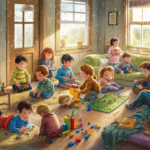Introduction
Science is all around us, and you don’t need a fancy laboratory to conduct mind-blowing experiments. In fact, you can perform amazing science experiments right in the comfort of your own home using everyday items! These experiments are not only fun and entertaining, but they also help you understand various scientific concepts in a hands-on way. So, get excited, gather the kids and take a look at these 10 mind-blowing science experiments for kids!
1. Magic Milk Experiment
Materials and Setup
Gather milk, food coloring, and dish soap.
Procedure
Pour milk into a shallow dish until it covers the bottom. Add a few drops of food coloring to the milk. Introduce a drop of dish soap into the center of the milk.
Observation
Watch as the colors begin to swirl and move in a mesmerizing display. This experiment teaches about surface tension and chemical reactions.
2. Homemade Lava Lamp

Materials and Setup
Prepare water, oil, food coloring, and Alka-Seltzer tablets.
Procedure
Fill a clear bottle one-third of the way with water. Add oil until the bottle is almost full. Drop in a few drops of food coloring. Add pieces of Alka-Seltzer tablets.
Observation
Observe the bubbles rising and falling, creating a lava lamp effect. This demonstrates how liquids of different densities interact.
3. Baking Soda and Vinegar Volcano

Materials and Setup
Collect baking soda, vinegar, dish soap, and food coloring, along with a container for the “volcano.”
Procedure
Fill the container with a few tablespoons of baking soda. Add dish soap and food coloring to the mixture. Pour in vinegar.
Observation
Witness the explosive reaction, showcasing the interaction between an acid (vinegar) and a base (baking soda), illustrating chemical reactions and pressure.
4. Invisible Ink

Materials and Setup
Get lemon juice or milk, a cotton swab, and a heat source or UV light.
Procedure
Use a cotton swab to write a secret message on paper with lemon juice or milk. Let it dry, then gently heat the paper or expose it to UV light.
Observation
See the hidden message appear, illustrating how heat or UV light can reveal certain substances.
5. Egg in a Bottle
Materials and Setup
Prepare a peeled hard-boiled egg, a bottle with a mouth slightly smaller than the egg, and matches or a piece of burning paper.
Procedure
Drop a piece of burning paper into the bottle. Quickly place the egg on top of the bottle’s opening.
Observation
As the flame goes out, watch the egg get sucked into the bottle due to changes in air pressure and the vacuum created.
6. Rainbow Paper
Materials and Setup
Gather water, paper towels, and markers.
Procedure
Dip a paper towel into water, then draw colorful designs on it using markers.
Observation
Watch the colors spread across the towel, demonstrating capillary action and chromatography.
7. Dancing Raisins

Materials and Setup
Prepare soda water and raisins.
Procedure
Drop a handful of raisins into a glass of soda water.
Observation
Observe the raisins rising and falling, appearing to “dance” due to the release of carbon dioxide bubbles, illustrating buoyancy and gas exchange.
8. Oobleck
Materials and Setup
Gather cornstarch and water.
Procedure
Mix cornstarch with water until a non-Newtonian fluid forms.
Observation
Watch the mixture act like a solid when struck but flow like a liquid when left alone, exploring the properties of matter. We love using the detailed instructions over in Instructables for this
9. Lemon Battery

Materials and Setup
Get lemons, copper and zinc nails, and wires.
Procedure
Insert the nails into the lemon. Connect wires to the nails.
Observation
Generate electricity, illustrating the basics of electrochemistry and circuits.
10. Cloud in a Jar
Materials and Setup
Prepare hot water, ice, and hairspray.
Procedure
Pour hot water into a jar. Cover the jar with a plate containing ice, and quickly spray hairspray inside.
Observation
See a cloud form inside the jar, demonstrating how clouds form in the atmosphere.
Conclusion
These 10 mind-blowing science experiments for kids using everyday items are not only educational but also a great way to have fun and get creative at home. So, gather your materials, follow the instructions, and prepare to be amazed by the wonders of science right in your own living room!



